NOAA’s 15th Arctic Report Card catalogs for 2020 the numerous ways that climate change continues to disrupt the polar region, with second-highest air temperatures and second-lowest summer sea ice driving a cascade of impacts, including the loss of snow and extraordinary wildfires in northern Russia.
The sustained transformation to a warmer, less frozen and biologically changed Arctic remains clear
Extreme warm air temperatures in the Eurasian Arctic illustrate significant region-wide effects of year-to-year variability and connections across the Arctic environment.
Highlights
-The average annual land surface air temperature north of 60° N for October 2019-September 2020 was the second highest on record since at least 1900. Record warm temperatures in the Eurasian Arctic were associated with extreme conditions in the ocean and on the land.
In the oceans
-Sea ice loss in spring 2020 was particularly early in the East Siberian Sea and Laptev Sea regions, setting new record lows in the Laptev Sea for June. The end of summer sea ice extent in 2020 was the second lowest in the 42-year satellite record, with 2012 being the record minimum year.
-August mean sea surface temperatures in 2020 were ~1-3°C warmer than the 1982-2010 August mean over most of the Arctic Ocean, with exceptionally warm temperatures in the Laptev and Kara seas that coincided with the early loss of sea ice in this region.
-During July and August 2020, regional ocean primary productivity in the Laptev Sea was ~2 times higher for July and ~6 times higher for August compared to their respective monthly averages.
-Bowhead whales have been a staple resource for coastal Indigenous peoples for millennia and are uniquely adapted for the arctic marine ecosystem. The Pacific Arctic population size has increased in the past 30 years likely due to increases in ocean primary production and northward transport of the zooplankton they feed on.
-Shifts in air temperatures, storminess, sea ice and ocean conditions have combined to increase coastal permafrost erosion rates, in regions where a high proportion of Arctic residents live and industrial, commercial, tourist and military activities are expanding.
On the land
-The exceptional warm spring air temperatures across Siberia resulted in record low June snow cover extent across the Eurasian Arctic, as observed in the past 54 years.
-Extreme wildfires in 2020 in the Sakha Republic of northern Russia coincided with unparalleled warm air temperatures and record snow loss in the region.
-Since 2016, tundra greenness trends have diverged strongly by continent, declining sharply in North America but remaining above the long-term average in Eurasia.
-From September 2019 to August 2020, the Greenland Ice Sheet experienced higher ice loss than the 1981-2010 average but substantially lower than the record 2018/19 loss.
-Glaciers and ice sheets outside of Greenland have continued a trend of significant ice loss, dominated largely by ice loss from Alaska and Arctic Canada.
Observing Arctic change
-Advancements in the integration of models and observations have increased the skill and utility of Arctic sea ice predictions on seasonal to decadal to century timescales.
-Important additions to the Arctic Observing Network (AON) systems and data products and advancements in process-level understanding have improved the quality and accessibility of information used to produce the Arctic Report Card.
-The unique Multidisciplinary drifting Observatory for the Study of Arctic Climate (MOSAiC) project concluded a historic, international, yearlong expedition into the Arctic ice pack in September 2020, collecting a legacy dataset that aims to advance the understanding, modeling and predicting of Arctic environmental change.
-Opening of the new NOAA Barrow Observatory, near Utqia?vik, Alaska, enables the continuation of nearly half a century of atmosphere and terrestrial in situ observations.
About Arctic Report Card 2020
The Arctic Report Card (hereafter 'ARC') has been issued annually since 2006. It is a timely and peer-reviewed source for clear, reliable, and concise environmental information on the current state of different components of the Arctic environmental system relative to historical records. The ARC is intended for a wide audience, including scientists, teachers, students, decision-makers, policymakers, and the general public, interested in the Arctic environment and science.
ARC 2020 contains 16 essay contributions prepared by an international team of 134 researchers from 15 different countries. As in previous years, independent peer review of ARC 2020 was organized by the Arctic Monitoring and Assessment Programme (AMAP) of the Arctic Council.
Source: Thoman, R. L., J. Richter-Menge, and M. L. Druckenmiller, Eds., 2020: Arctic Report Card 2020, https://doi.org/10.25923/mn5p-t549.
